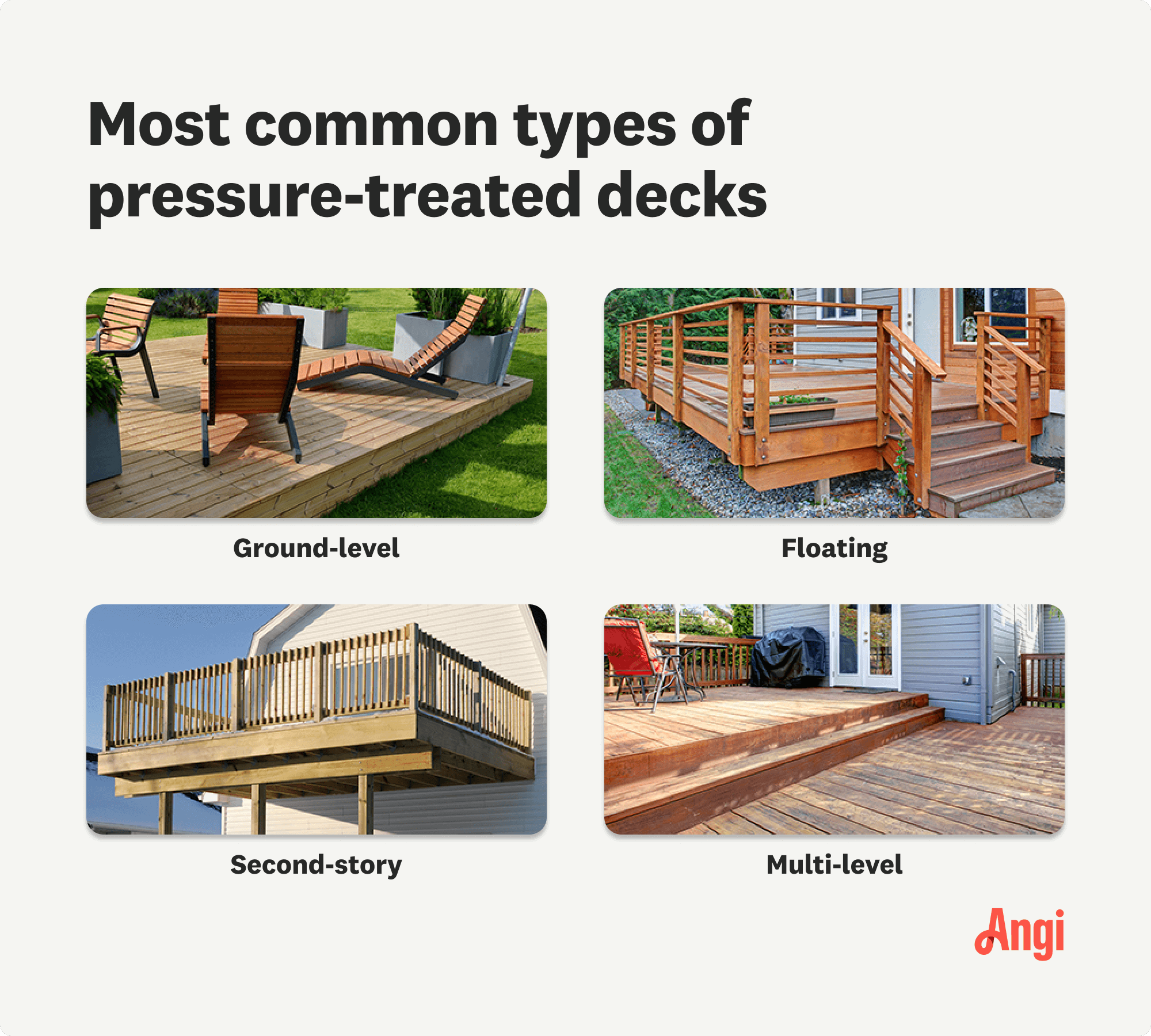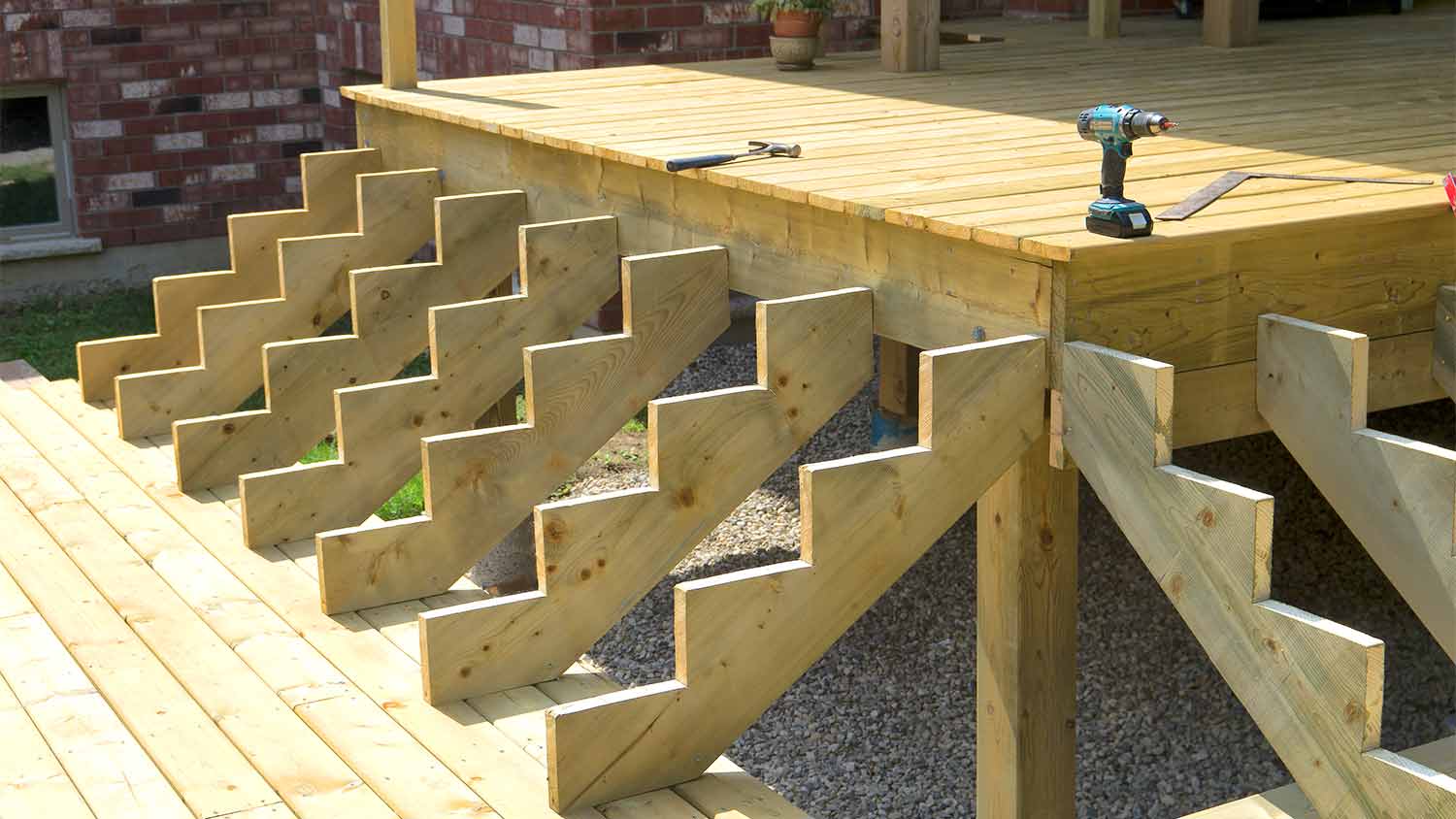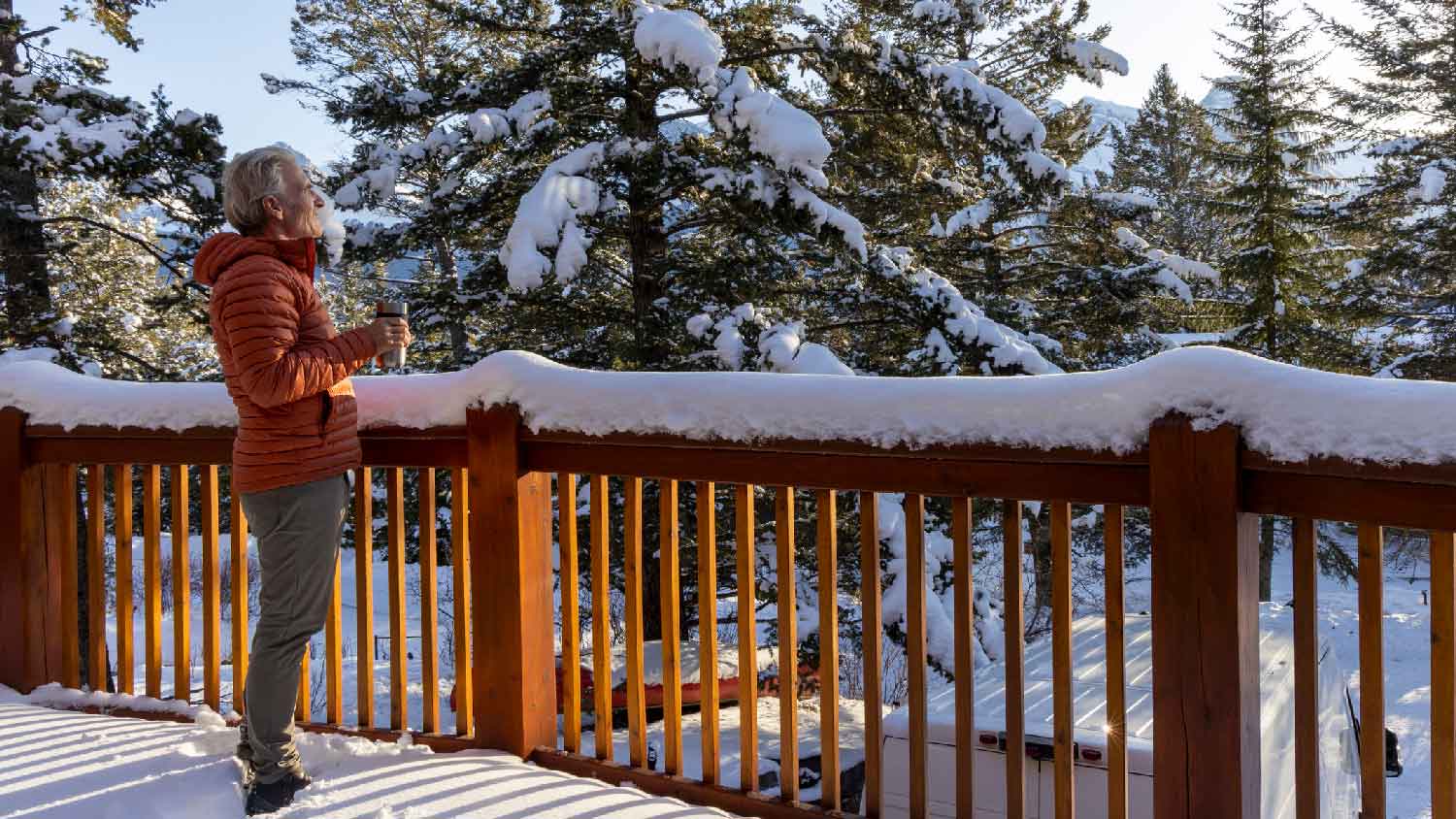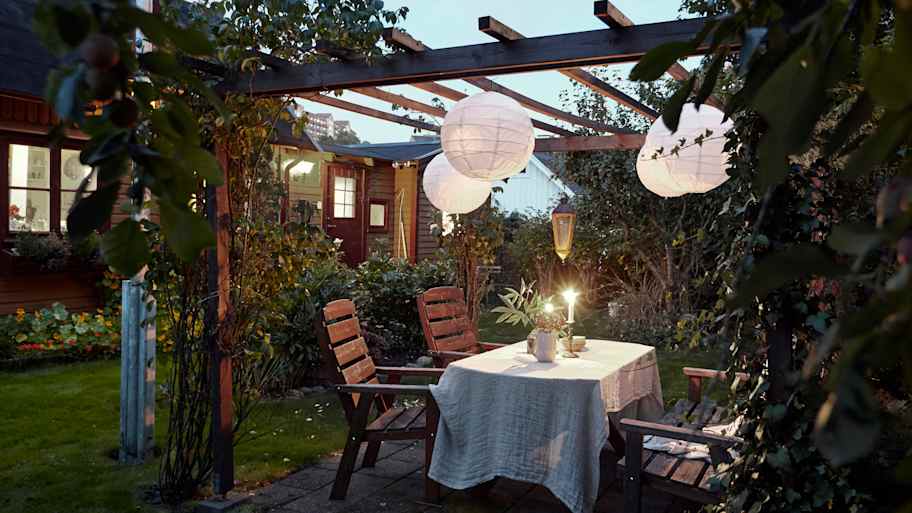
Refinishing your deck is a great way to restore its appearance and fall in love with your outdoor space. Use this guide to learn how much it costs based on factors like size and type.
A pressure-treated wood deck costs $8,000, on average, with prices falling between $4,000 and $12,000 for standard projects.


A pressure-treated wood deck costs an average of $8,000, and most homeowners pay between $4,000 and $12,000. Factors like the size and type of deck, the quality of the lumber, and site preparation can all affect your total. You could pay as little as $2,000 for a small ground-level deck or as much as $43,200 for a multi-level deck.
How much you’ll pay for a pressure-treated wood deck depends on many different cost factors. Let’s take a look at the main things to consider to get an accurate estimate.
The type of deck you’re building has a significant impact on your project cost. For example, if you’re building a floating deck, your price tag will be lower than if you build a deck attached to your home or a multi-story deck with a more complex design. The table below includes average prices for different types of pressure-treated decks at an average size of 350 square feet.
| Type of Deck | Average Cost |
|---|---|
| Floating | $7,000–$21,000 |
| Ground-level | $5,300–$6,300 |
| Multi-level | $10,500–$26,300 |
| Second-story | $14,000–$17,500 |
The average pressure-treated deck cost per square foot is $40, and your price can range from $15 up to $75 per square foot, depending on the type of deck, the location, and the number of footings you need. Many contractors will offer discounts on the per-square foot cost for larger decks and more guaranteed work, but your total will always be higher as the size of the deck increases.
| Deck Size | Average Cost | Cost Range |
|---|---|---|
| 10 x 10 | $4,000 | $1,500–$7,500 |
| 12 x 12 | $5,800 | $2,200–$10,800 |
| 12 x 16 | $7,700 | $2,900–$14,400 |
| 12 x 20 | $9,600 | $3,600–$18,000 |
| 14 x 20 | $11,200 | $4,200–$21,000 |
| 16 x 20 | $12,800 | $4,800–$24,000 |
| 20 x 20 | $16,000 | $6,000–$30,000 |
| 20 x 24 | $19,200 | $7,200–$36,000 |
| 24 x 24 | $23,100 | $8,700–$43,200 |
You can choose from standard pressure-treated lumber and ground-contact pressure-treated lumber for your decking materials. Professionals will use ground-contact lumber for pieces connected to footings, those that will contact the soil, and structural components, like joists. For deck boards, you can choose either. Ground-contact lumber will cost 30% to 50% more but will also stand up to the elements and repel wood-destroying insects better.
A wood deck requires concrete for footings, hardware, brackets, and lumber in a variety of dimensions, but you can get a good estimate for the total cost of your materials by assuming an average cost of $10 to $25 per square foot. The remainder of your total will go toward labor.
Labor accounts for between 50% and 70% of your total. The labor cost to build a deck per square foot is between $8 and $40, or between $4,000 and $5,600 for a standard-size deck. Labor costs can increase with deck complexity and design, the type of deck you’re installing, and the cost of living in your area.

You’ll also want to factor in the cost of preparing your deck’s foundation if you don’t already have one and need one for your deck type. This expense can add anywhere between $25 and $300 per foundation post. If you’re simply replacing old decking with new pressure-treated wood, you may be able to salvage your current foundation and avoid this expense.
Where you decide to install your deck has a major impact on your project’s cost. A second-story deck, also known as a balcony deck, is more expensive to build than a first-story deck because of the additional materials and reinforcement costs. Additionally, if your yard isn’t conducive to the use of machinery to transport materials or mix and pour concrete for the footings, you could pay higher prices for manual labor.
Decks with footings are considered permanent improvements to your property and will require a permit, which will add between $50 and $250 to your total, depending on your location. Some municipalities may not require permits at all, so you should check with your professional or your local building department to confirm during your planning stage.

The type of deck you’re building can drastically increase the cost of your project. With that in mind, here is a breakdown of the different types of decks and how much you can expect to spend.
Anticipate spending between $15 and $25 per square foot, or $20 per square foot on average, to construct a pressure-treated, ground-level deck. A ground-level deck is the most common. It’s attached to the back of the house on one end and rests on footers on the other. These straightforward decks don’t usually have a stairway or railings, which keeps installation costs low.
Floating decks cost anywhere between $20 and $60 per square foot. A floating deck or freestanding deck is a stand-alone structure that, as you probably guessed, doesn’t connect to your home. These are common around pools and in larger yards where homeowners want a standalone spot to entertain. This deck type needs additional framing materials and additional concrete footings for support.
A second-story deck, also called a raised deck, costs between $40 and $50 per square foot to install. This type of deck needs footings and often makes use of larger posts—6-inch-by-6-inch or 8-inch-by-8-inch posts—for extra support. As such, you’ll see an increase in the cost per square foot.

On average, building a multi-level deck ranges between $30 and $75 per square foot. Multi-level decks require more design components and materials than most of the other options, including steps, a stairway, and pillars or posts, putting them at the top of the price range.
On top of your normal up-front costs, it’s also important to factor in costs that you’ll incur over time. Below are a few of the most common additional costs associated with treated lumber decks.
Deck maintenance can be a costly undertaking, but maintaining your deck is an essential part of deck safety. You’ll need to inspect your deck’s surface annually, clean your deck on an as-needed basis, and seal your deck every one to two years. Sealing a deck costs between $0.75 and $4 per square foot, but you can keep costs to a total of $30 to $80 by doing the work yourself. It’s also a good idea to remove leaves regularly to avoid rot and give your deck a visual inspection after extreme weather conditions.
The cost to repair a deck ranges anywhere from $800 to $3,200 on average. Pressure-treated lumber prices fall between $10 and $25 per square foot to replace, and your total will depend on the extent and location of the damage.
Adding a deck to your property may increase the value of your home, but it can also lead to an increase in your homeowner's insurance premium, and any deck with footings will cause your property taxes to go up. Contact your insurance company and your local department of taxation and finance before you start building your deck to avoid any surprise charges.

If you choose to install a pressure-treated deck yourself, you’ll save an average of $4,000 on labor costs. While this is certainly an appealing option to consider, note that installing a deck on your own is a complicated project that requires pouring concrete, leveling footings, and installing posts, deck boards, and railings. Mistakes can lead to warping lumber, a decreased deck lifespan, and an unsafe outdoor space.
If you’re not skilled with masonry, structural construction, and carpentry, hire a deck builder near you to ensure your new deck is safe to walk on, looks beautiful, and will stand the test of time. Hiring a pro is an especially good idea if you’re looking to install a second-story deck or a multi-story deck requiring more expertise to install something safe and professional.
While you’re budgeting for your new wood deck, you may want to consider the following add-on services that can help elevate your outdoor space and add even more value to your property.
Cost to add deck stairs: $100–$200 per step
Landscaping lighting cost: $3,000–$6,000
Fire pit cost: $200–$3,000
Outdoor furniture cost: $200–$1,800
Retractable awning cost: $1,500–$3,500
The cost of building a deck can quickly get out of hand and push you over budget. As such, finding ways to save on your total cost can help you keep some of that investment safe and sound in your wallet. Follow these tips to reduce the cost of your pressure-treated deck.
Build a smaller deck. Every additional ten square foot you install will bump up your total by an average of $4,000.
Choose materials wisely. You should always use ground-contact lumber for posts and any portion that may come in contact with the soil or vegetation, but you could save 30% to 50% on the cost of some materials by choosing aboveground deck boards and railings.
Pick a ground-level deck instead of a raised or multi-level deck. If your space allows for it, a ground-level deck can easily be half the cost of more complex deck types.
Compare local installation prices to find the best deal. Shop around and get at least three estimates to compare.
Pick an off-season time to build. Landscaping companies are busiest in the spring and summer. Consider installing your deck in the fall or winter to save.
Maintain your deck yourself. You can save in the long run by resealing your deck and carrying out minor repairs yourself rather than hiring a pro. Maintenance will also help your deck last longer.
Home is the most important place on earth, which is why Angi has helped more than 150 million homeowners transform their houses into homes they adore. To help homeowners with their next project, Angi provides readers with the most accurate cost data and upholds strict editorial standards. We extensively research project costs to develop the pricing data you see, so you can make the best decisions for you and your home. We rely on reputable sources, including the U.S. Bureau of Labor Statistics, academic journals, market studies, and interviews with industry experts—all to ensure our prices reflect real-world projects.
Want to help us improve our cost data? Send us a recent project quote to [email protected]. Quotes and personal information will not be shared publicly.
From average costs to expert advice, get all the answers you need to get your job done.

Refinishing your deck is a great way to restore its appearance and fall in love with your outdoor space. Use this guide to learn how much it costs based on factors like size and type.

Trex decking can offer your home a beautiful, durable outdoor oasis. Learn all about the costs of Trex decking based on space, size, and style.

Flagstone patio costs vary by the size, material type, labor, and more. Stay tuned to see how much your flagstone patio could cost.

Learning how to winterize a deck can protect your outdoor space from harsh weather. Here’s how to do it properly so you can enjoy a fresh deck next summer.

When determining how to plan a deck, follow these tips to account for regulations, functional needs, landscaping issues, material differences, and more.

A pergola can add to your home value and yard utility. Learn about standard pergola sizes and how to choose dimensions for the most useful yard area possible.